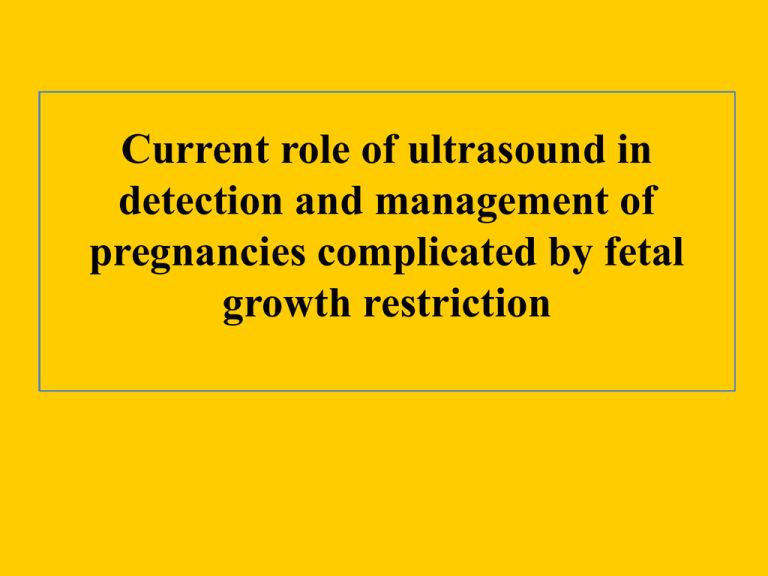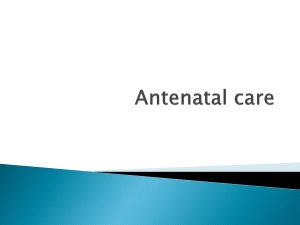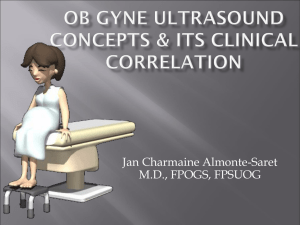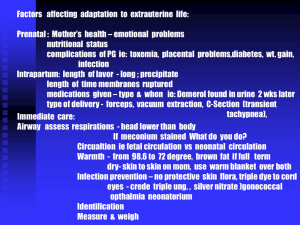Fetal growth restriction - obgynkw
advertisement

Current role of ultrasound in detection and management of pregnancies complicated by fetal growth restriction FGR : Magnitude of the problem * Perinatal mortality 120/1000 * 2nd leading contributor to perinatal mortality rate * 40% of all stillbirths are IUGR What is in a name ? Intrauterine growth retardation Intrauterine growth restriction Fetal growth restriction Small for gestational age (IUGR) (IUGR) (FGR) (SGA) Definition : Fetal growth restriction * Ultrasound estimated fetal weight or abdominal circumference suboptimal for gestational age * FGR = FETAL diagnosis ( not neonatal ) * Defining threshold : < 10th centile for gestational age < 5th centile for gestational age (worse outcome) Definition : Small for gestational age (SGA) * Birth weight suboptimal for gestational age * SGA = NEONATAL diagnosis (not fetal) * Defining threshold : < 10th centile for gestational age Birth ratio : Actual birth weight / Expected birth weight SMALL FETUS CHECK DATING OF THE PREGNANCYPREVIOUS DATING SCAN EXAMINE FOR: -FETAL BIOMETRY -FETAL ABNORMALITIES/MARKERS -FETAL MOVEMENTS -AMNIOTIC FLUID INDEX -DOPPLERS -SYMMETRICALLY SMALL -NO ANOMALIES/ MARKERS -NORMAL ACTIVITY -NORMAL AMNIOTIC FLUID -NORMAL DOPPLERS ASSYMMETRICALLY SMALL -NO ANOMALIES / MARKERS -REDUCED ACTIVITY -REDUCED AMNIOTIC FLUID -ABNORMAL UTERINE OR FETOPLAC, DOPPLERS -SYMMETRICALLY OR ASSYMMETRICALLY SMALL -FETAL ANOMALIES AND/OR ABNORMAL MARKERS -ACTIVITY NORMAL OR REDUCED -AMNIOTIC FLUID REDUCED, NORMAL OR INCREASED WRONG DATES OR CONSTITUTIONALLY SMALL FETUS REPEAT SCAN IN 2-4 WEKS TO ENSURE LINEAR FETAL GROWTH PLACENTAL INSUFFICIENCY -UTERINE/FETOPLAC DOPPLER USUALLY NORMAL FETAL ABNORMALITY SERIAL GROWTH SCANS AND DOPPLERS TO TIME DELIVERY OFFER INVASIVVE ASSESSMENT CONGENITAL INFECTION SCREEN SMALL FETUS CHECK DATING OF THE PREGNANCYPREVIOUS DATING SCAN EXAMINE FOR: -FETAL BIOMETRY -FETAL ABNORMALITIES/MARKERS -FETAL MOVEMENTS -AMNIOTIC FLUID INDEX -DOPPLERS -SYMMETRICALLY SMALL -NO ANOMALIES/ MARKERS -NORMAL ACTIVITY -NORMAL AMNIOTIC FLUID -NORMAL DOPPLERS -SYMMETRICALLY OR ASSYMMETRICALLY SMALL -NO ANOMALIES / MARKERS -REDUCED ACTIVITY -REDUCED AMNIOTIC FLUID -ABNORMAL UTERINE OR FETOPLAC, DOPPLERS ASSYMMETRICALLY SMALL -FETAL ANOMALIES AND/OR ABNORMAL MARKERS -ACTIVITY NORMAL OR REDUCED -AMNIOTIC FLUID REDUCED, NORMAL OR INCREASED WRONG DATES OR CONSTITUTIONALLY SMALL FETUS REPEAT SCAN IN 2-4 WEKS TO ENSURE LINEAR FETAL GROWTH PLACENTAL INSUFFICIENCY -UTERINE/FETOPLAC DOPPLER USUALLY NORMAL FETAL ABNORMALITY SERIAL GROWTH SCANS AND DOPPLERS TO TIME DELIVERY OFFER INVASIVVE ASSESSMENT CONGENITAL INFECTION SCREEN SMALL FETUS CHECK DATING OF THE PREGNANCYPREVIOUS DATING SCAN EXAMINE FOR: -FETAL BIOMETRY -FETAL ABNORMALITIES/MARKERS -FETAL MOVEMENTS -AMNIOTIC FLUID INDEX -DOPPLERS -SYMMETRICALLY SMALL -NO ANOMALIES/ MARKERS -NORMAL ACTIVITY -NORMAL AMNIOTIC FLUID -NORMAL DOPPLERS -SYMMETRICALLY OR ASSYMMETRICALLY SMALL -NO ANOMALIES / MARKERS -REDUCED ACTIVITY -REDUCED AMNIOTIC FLUID -ABNORMAL UTERINE OR FETOPLAC, DOPPLERS ASSYMMETRICALLY SMALL -FETAL ANOMALIES AND/OR ABNORMAL MARKERS -ACTIVITY NORMAL OR REDUCED -AMNIOTIC FLUID REDUCED, NORMAL OR INCREASED WRONG DATES OR CONSTITUTIONALLY SMALL FETUS REPEAT SCAN IN 2-4 WEKS TO ENSURE LINEAR FETAL GROWTH PLACENTAL INSUFFICIENCY -UTERINE/FETOPLAC DOPPLER USUALLY NORMAL FETAL ABNORMALITY SERIAL GROWTH SCANS AND DOPPLERS TO TIME DELIVERY OFFER INVASIVVE ASSESSMENT CONGENITAL INFECTION SCREEN “ I AM A FETUS IN THE WOMB I FEAR IT MAY BECOME MY TOMB IF ONLY I COULD GIVE A SHOUT TO MAKE MY DOCTOR GET ME OUT!” UNKNOWN MEDICAL STUDENT DUBLIN, UK 1982 Dilemmas in FGR How to monitor cCTG Arterial Dopplers Venous Dopplers Biophysical profile When to deliver? Dilemmas in management of FGR * Severe FGR due to placenta dysfunction - Progressive - No treatment to reverse the process * Timing of delivery - Risks : prematurity vs continued intrauterine life * Objective - Buy time to reduce prematurity risks, but deliver prior to organ damage * Question : Can this be accomplished ? * Answer : DOPPLER Hecher K et al : Monitoring of fetuses with IUGR : a longitudinal study. UOG 2001; 18:564-570 Baschat AA et al: The sequence of changes in Doppler and BPP as severe FGR worsens. UOG 2001; 18: 571-577 Ferrazzi E et al : Temporal sequence of abnormal Doppler changes in severe IUGR. UOG 2002; 19: 140-146 Phases of placental dysfunction causing FGR Patterns of clinical progression in early FGR STV and metabolic acidosis in IUGR STV (msec ) <2.6 2.6-3.0 > 3.0 ----------------------------------------------------------------------------------Gestation (wks ) 25-38 26 – 38 27 – 37 Metabolic acidosis * 10.3% 4.3% 2.7% IUFD 24.1% 4.3% 0.0% ----------------------------------------------------------------------------------* pH< 7.12 ; base deficit >12 mmol/l Pardey J et al AJOG 2002; 186:1095-1103 IUGR : DV , STV and perinatal mortality n alive IUFD NND ----------------------------------------------------------------------------------Both abnormal 33 20 6 7 13/33 (39%) Both normal/or one abnormal 60 56 0 4 4/60 (7%) ----------------------------------------------------------------------------------Total 93 76 6 11 Hecher K et al, UOG 2001 Derks JB et al: The effects of maternal betamethasone administration on the fetus. BJOG 1995; 102:40-46 within 48 hours after initial betamethasone administration : * Reduction of fetal movements * Reduction of fetal breathing movements * Reduction of STV on NST All changes disappeared after 4 days following treatment Thuring A et al: Effect of maternal betamethasone on fetal and uteroplacental blood flow .UOG 2011; 37: 668672 within 48 hours after initial betamethasone administration : * decreased UMA diastolic flow * decreased DV flow at time of atrial contraction * no changes of MCA and UTA flows All changes disappeared after 4 days following treatment Patterns of clinical progression in late FGR LATE-ONSET FGR AND NEURODEVELOPMENTAL DELAY Late-onset FGR > 34 wks Normal or UMAPI MCAPI Intracerebral Redistribution of Blood Flow Frontal Lobes Basal ganglia Neurodevelopmental delay Neonatal period Early childhood Socialinteractive attention Impaired -Performance attention -Communication -Problem solving -Emotions -Social function Cruz-Martinez R et al, AJOG 2009 Review of determinants of fetal neurodevelopment. FGR monitoring – key points * UMA flow is useful parameter for assessment of high-risk population not a screening test * UMA flow unless it is severely abnormal does not tell us anything about fetal condition * MCA flow reflects the extent of fetal “brain sparing”=sign of arterial redistribution as fetal response to hypoxemia * One of drawbacks of existing fetal arterial redistribution is subsequent development of oligohydramnios *Computerized CTG is currently the best parameter to detect fetal acidosis by decreased STV ( < 3 msec) * Ductus venosus flow indirectly reflects the efficiency of the fetal heart and seems to correlate with the presence or absence of metabolic acidosis * Longitudinal monitoring ( at least 3 detailed studies) facilitates definition of trends of evaluated parameters in FGR. Different fetuses are showing different responses to impaired placental function i.e. all fetuses should be used as their own control FGR delivery timing – key points * As IUGR fetus decompensates there are progressive Doppler velocimetry changes * These Doppler changes usually tend to follow a consistent pattern and largely occur prior to abnormalities in BPP. * Abnormal DVPI and STV values are important indicators for the optimal timing of delivery before 32wks of gestation * Metabolic acidosis, not necessarily hypoxia, correlates with neurological outcome in the infant * Gestational age overrides the effect of fetal cardiovascular condition until 32-34 weeks * Neurodevelopment is affected by severely abnormal UMA and DV flows in early-onset FGR and by abnormal MCA flow in late-onset FGR FGR MANAGEMENT PROTOCOL 26-34 weeks NST & Doppler studies NST Reactive 34-36 weeks NST & Doppler studies NST Non-Reactive UMA Doppler Reassuring UMA Doppler Non-Reassuring Repeat in 1W Venous Doppler BPP < 4 Reassuring Non-reassuring Repeat in 1W Deliver BPP 6 Both Tests Reassuring Either Test Non-Reassuring Repeat in 1W Deliver Deliver Repeat in 6-24 hours Callen 2010 LOOK TO THE FUTURE








